The Nordic region is a fascinating market that has produced players such as Pernille Harder, Stina Blackenstenius and Caroline Hansen.
More recently, players such as Maiko Hamano, who moved from Hammarby to Chelsea, Matilda Vinberg from Hammarby to Tottenham and Oona Sevenius, who moved from HJK to AC Milan and currently plies her trade for surprise package Como.
In this data analysis, we have used data and statistics to highlight some of the leading young attacking players currently playing in this part of the world and look at who could develop into something more in the future.
Criteria
To qualify for our data set, you had to be currently playing in the Nordic region; we’ve focused on Denmark, Sweden, Norway, Finland and Iceland for this piece.
Then, you must have been U23 at the end of your last season, and you must have played at least half of the minutes for your side in the past or current season, with all of Sweden, Norway, Finland and Iceland playing a calendar year season (i.e. January-December) as opposed to Denmark who plays a European football season (i.e. August-June.)
This left us with 129 players to analyse. As such, we will outline four interesting players that intrigued us as we looked through the data.
Anna Jøsendal (Norway) – Rosenborg/Hammarby – Left Winger
One of the first players that stood out in our data set was new Hammarby signing Anna Jøsendal. She played last season for Rosenborg in Toppserien, where they finished the 2023 campaign in second place. Now, let’s get into what made Jøsendal stand out so significantly.
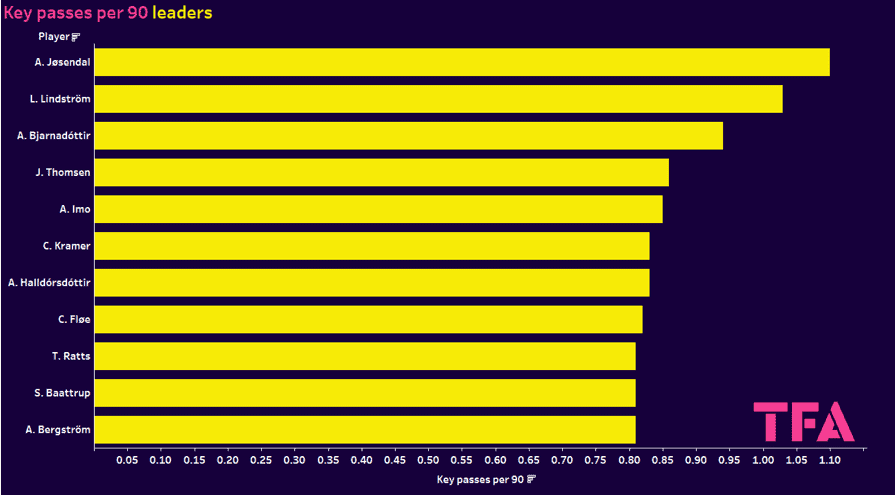
The first thing we did was identify some of the key leaders in our data set regarding chance creation. To do this, we looked at key passes, where Jøsendal leads the way with an average of 1.1 per 90, 0.07 ahead of the next best, Lotta Lindstrom.
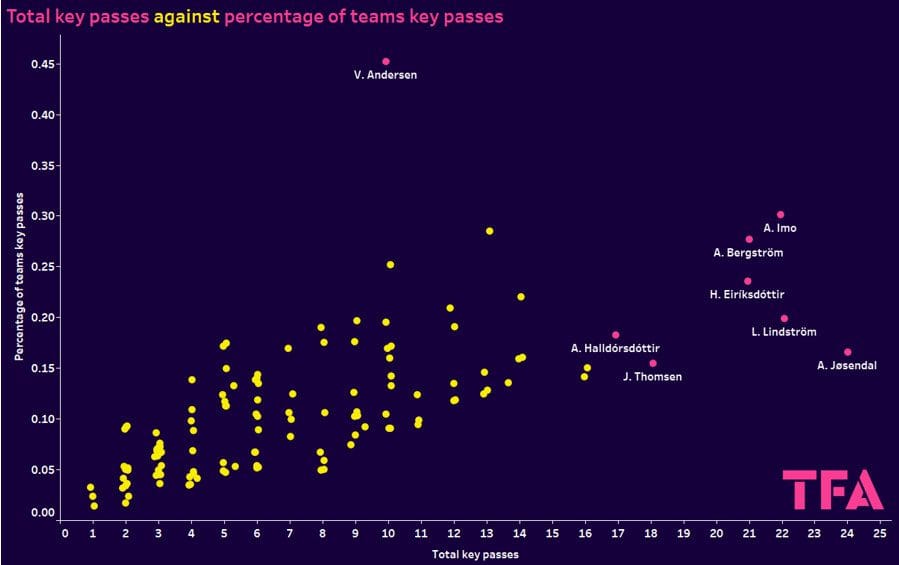
Then, we took a deeper look into the numbers and looked at how integral the players were to each other’s teams in terms of key passes. We did this by comparing the total number of key passes completed by each player with the percentage of their team’s key passes completed.
What did this prove? Well, first of all, it indicates that although she is not the only creator on her side, she is still creating a significant proportion of her side’s chances at 17%. One reason behind this was that the Rosenborg side that Jøsendal plays with actually had the second-most key passes completed as a group, which would skew the data in one direction.
Compared to players such as Danish forward Vibeke Andersen (ThistedQ) and Nigerian forward Anam Imo (Pitea), who led in terms of percentage of their respective team’s key passes at 45% and 30% on weaker teams.
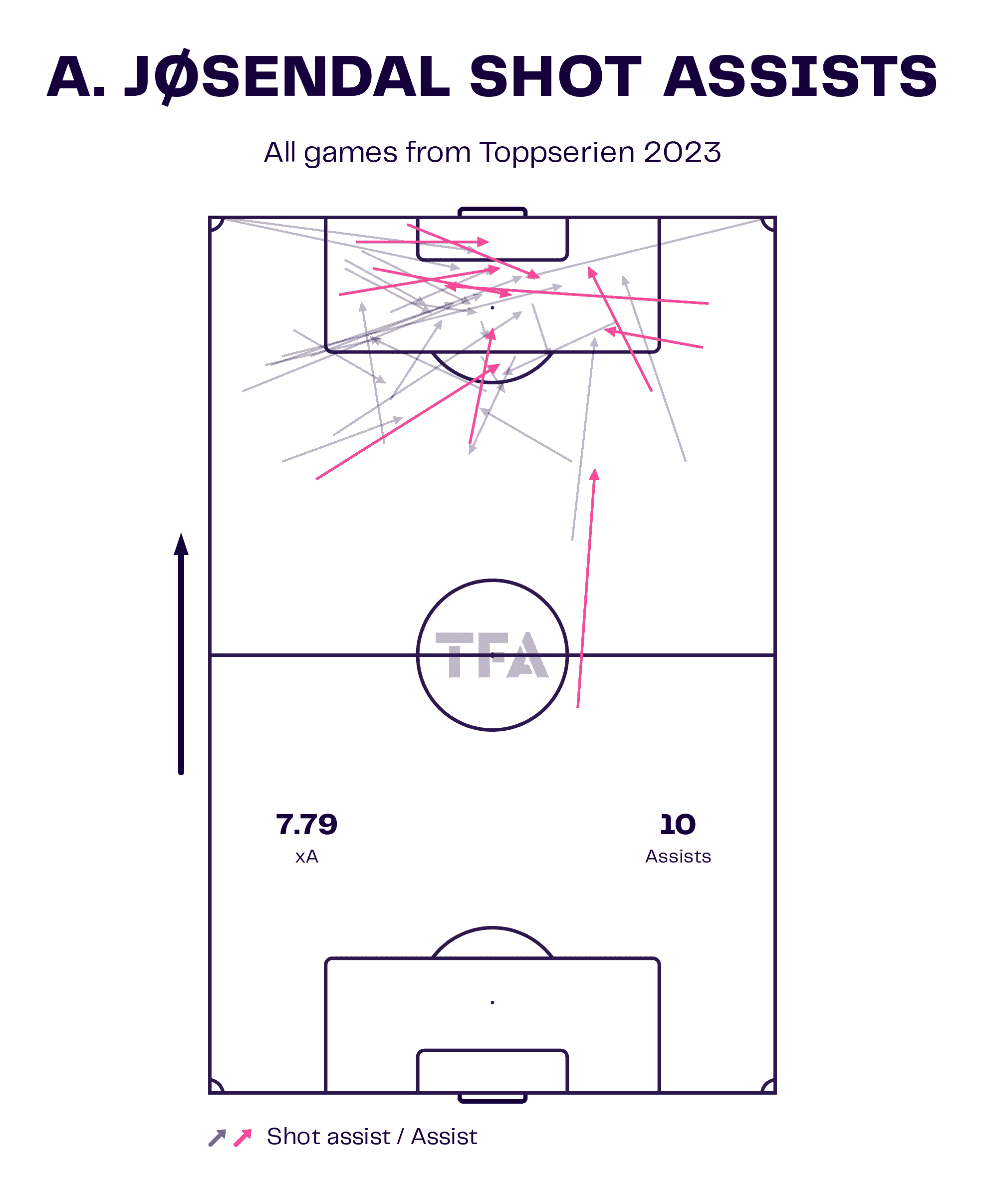
So now we have a brief idea of what makes Jøsendal stand out. Let’s take a look more specifically at what makes her so impressive. So what we did was look at the location of the majority of her shot assists or, in other words, her chances created. What stands out is how the locations are from wide areas, such as a winger. So, the next idea we looked at was how she performs as a crosser.
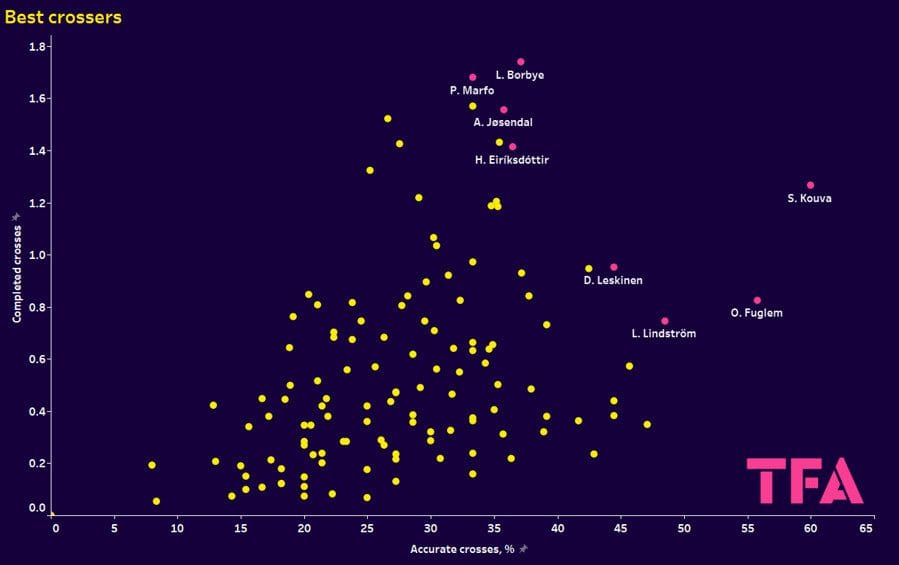
So here we looked at how accurate these players were at crossing against how many crosses they completed per game. As you can see again, Jøsendal is one of the better performers in this category, completing the fourth most crosses per game at an accuracy of 35.79%.
As you can see, Jøsendal stands out in several key creative areas, which is why Hammarby have likely just signed her on a free from Rosenborg as a likely replacement for Matilda Vinberg, who Tottenham have just signed.
Ásdís Karen Halldórsdóttir (Iceland) – Valur Rekyjavik – Right/Left Winger
The next player that stood out in our analysis is Icelandic winger Ásdís Karen Halldórsdóttir. She plies her trade in the Urvalsdeild Kvenna — Iceland’s top division — and helped Valur win the league last term. Here, we will outline some key statistics that show why.
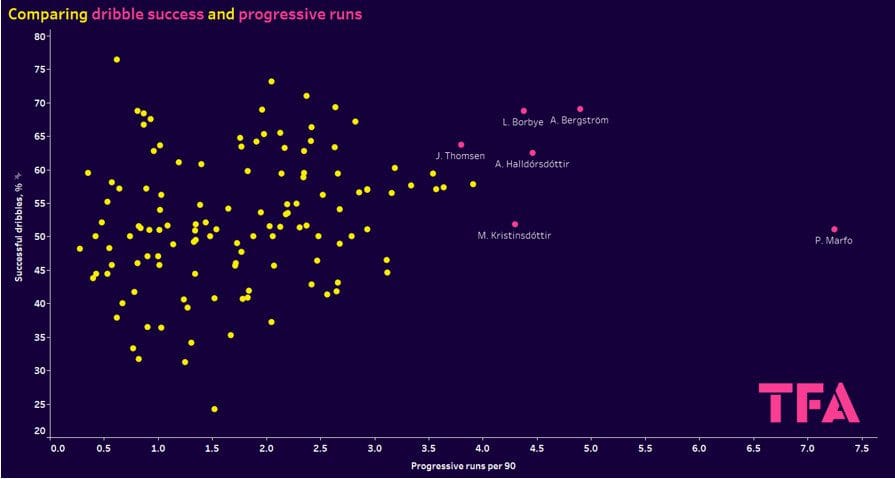
The first area where Halldórsdóttir stood out was her ability to complete a high number of dribbles to help progress the ball up the field for her side—averaging the third most progressive runs per 90 at 4.46. This is coupled with a comparatively high completion rate of 62.5%. This makes her a real asset for her side regarding the ball driving forward in attack.

Then, to try and back up these findings, we wanted to see how much of the ball Halldórsdóttir was getting, and it turns out she was completing a high proportion of the dribbles in totality. She completed 33% of Valur’s dribbles, the third-highest ratio behind Swedish forward Frida Thornqvist and young Ghanaian forward Princess Marfo.
However, what sets Halldórsdóttir apart from the likes of Thornqvist and Marfo is her ability to couple her ability to progress the ball with her feet with her ability to create goalscoring chances.

Here again, we take a look at the number of key passes per 90 leaderboard. Halldórsdóttir sits in seventh position, averaging 0.83 key passes per 90. This is 18% of the team’s total key passes made.
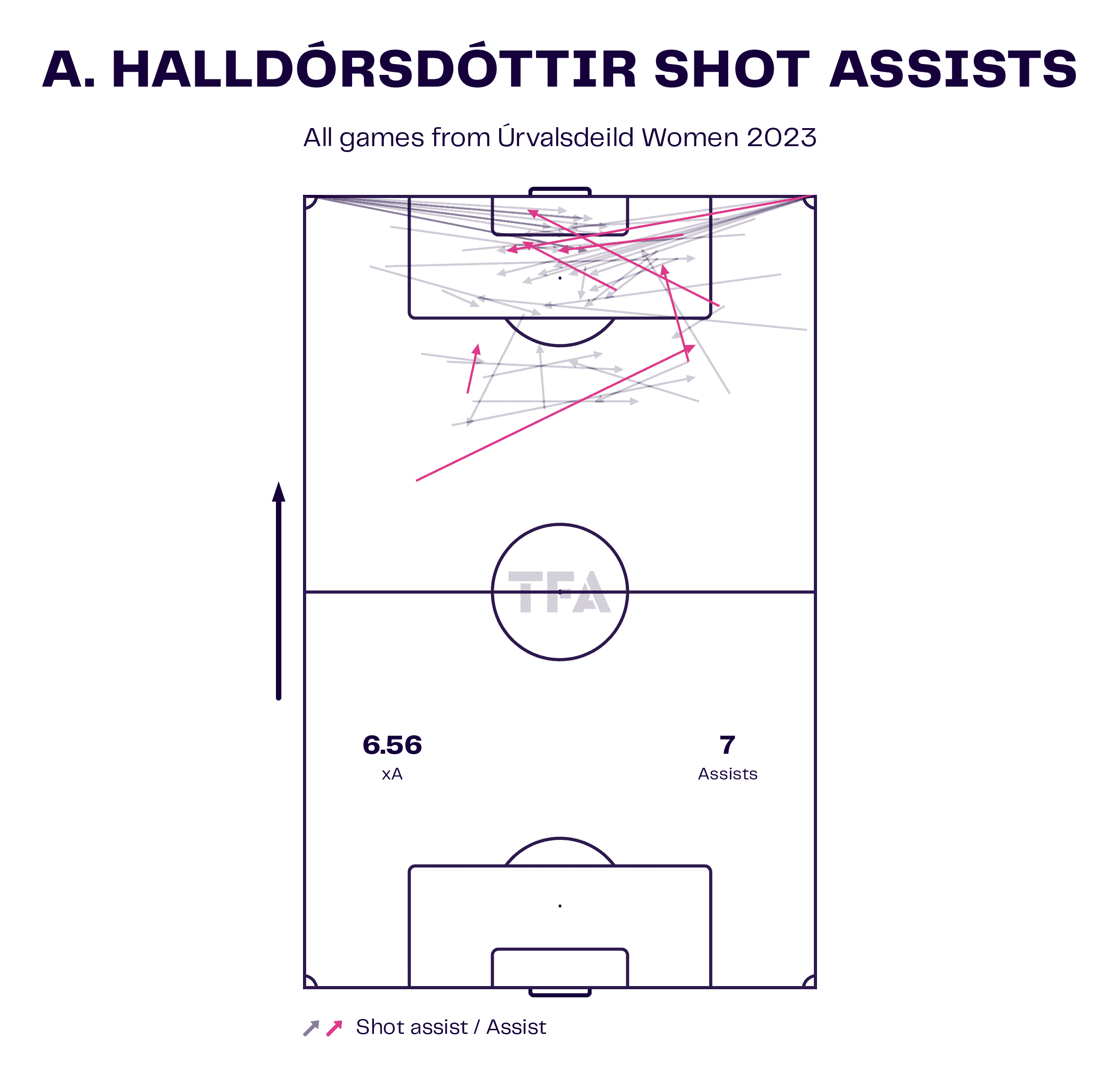
Having discovered this, we wanted to examine the areas where Halldórsdóttir is creating these goalscoring opportunities. This diagram suggests that there are a large number of the chances she creates from set pieces. However, interestingly enough, when you look at where she is getting her assists from, she has only got one assist from a corner, with her seven assists coming from open play.
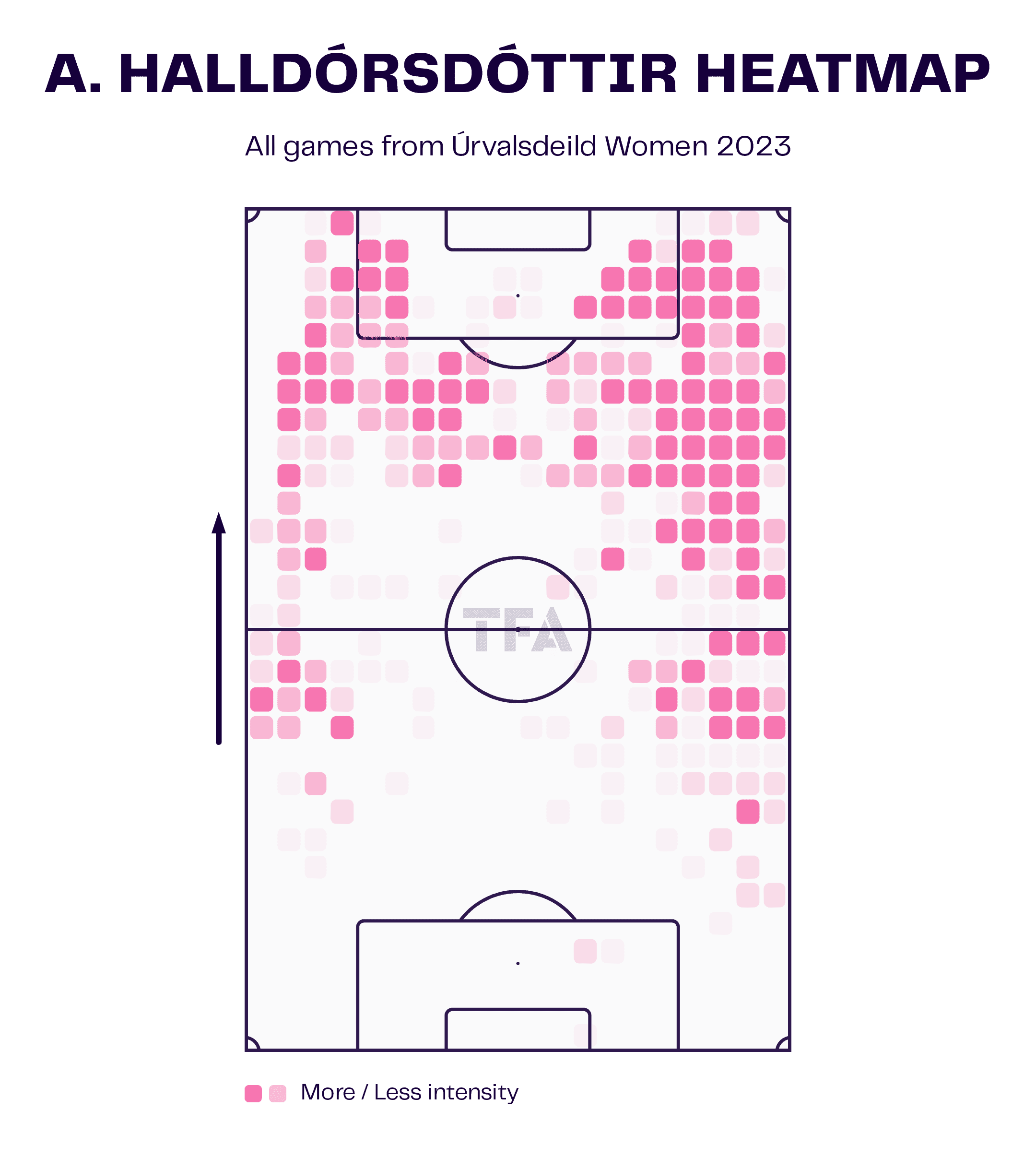
As you can see, Halldórsdóttir is a dangerous dribbling forward who can create another interesting aspect of her game. However, her versatility and ability to play on both wings appear to favour the right wing. This heatmap also shows how versatile she is to play on the left side.
Emilía Kiær Ásgeirsdóttir (Denmark) – Nordsjaelland – Striker
The young 18-year-old Danish forward Emilía Kiær Ásgeirsdóttir is another player who stood out to us as a promising young player when we looked through the data.
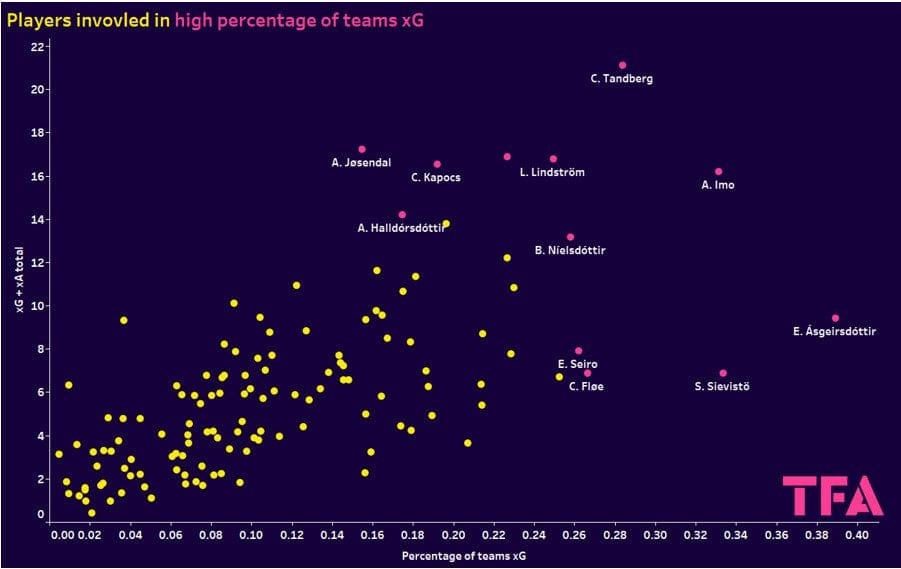
The first way that Ásgeirsdóttir stood out was by combining the xG and xA over the season to create value for each player’s total expected goal involvement. We then compared it to the percentage of the team’s xG. When we did this, Ásgeirsdóttir stood out to us as she leads the way in terms of proportion of teams xG, with her being involved with 39% of her side’s chances created over 5% better than the next best, Sara Sievisto. This stood out to us as important as it implies that she is more integral to her side than other players. Given that the Nordsjaelland side sit second in their division.
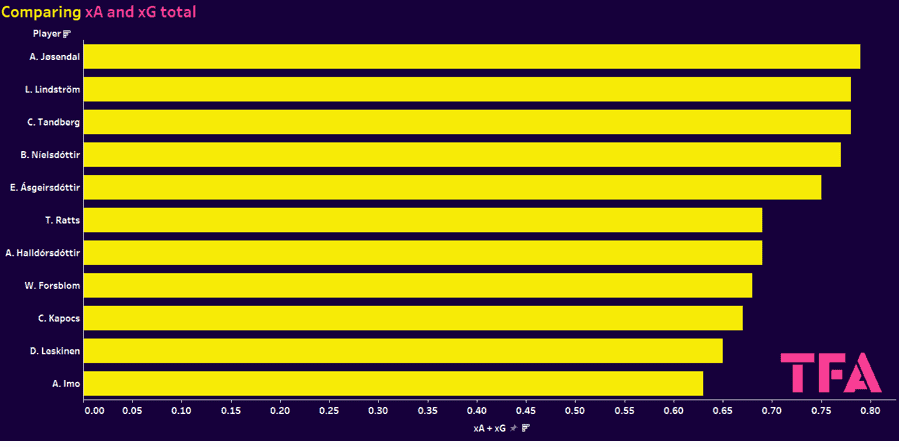
This is then supported by this graph, which details the most xG and xA per game by all the players in our data set. As you can see, Asgeirsdottir is in fifth with a 0.75 per game. Similarly, with the seventh-most goal involvements at 0.79 per game, 45% of her side’s total goal involvements, she leads our dataset in this area.
Then, after finding out what an integral member of the team’s ability to score goal Asgeirsdottir is, we wanted to find more detail as to how these chances were coming about. The first thing we noticed was that although she is averaging a high xA and xG total, most of this comes from xG itself, averaging 0.64 xG per game and only 0.08 xG per game. As such, we wanted to look at a shot location map to understand the data better.
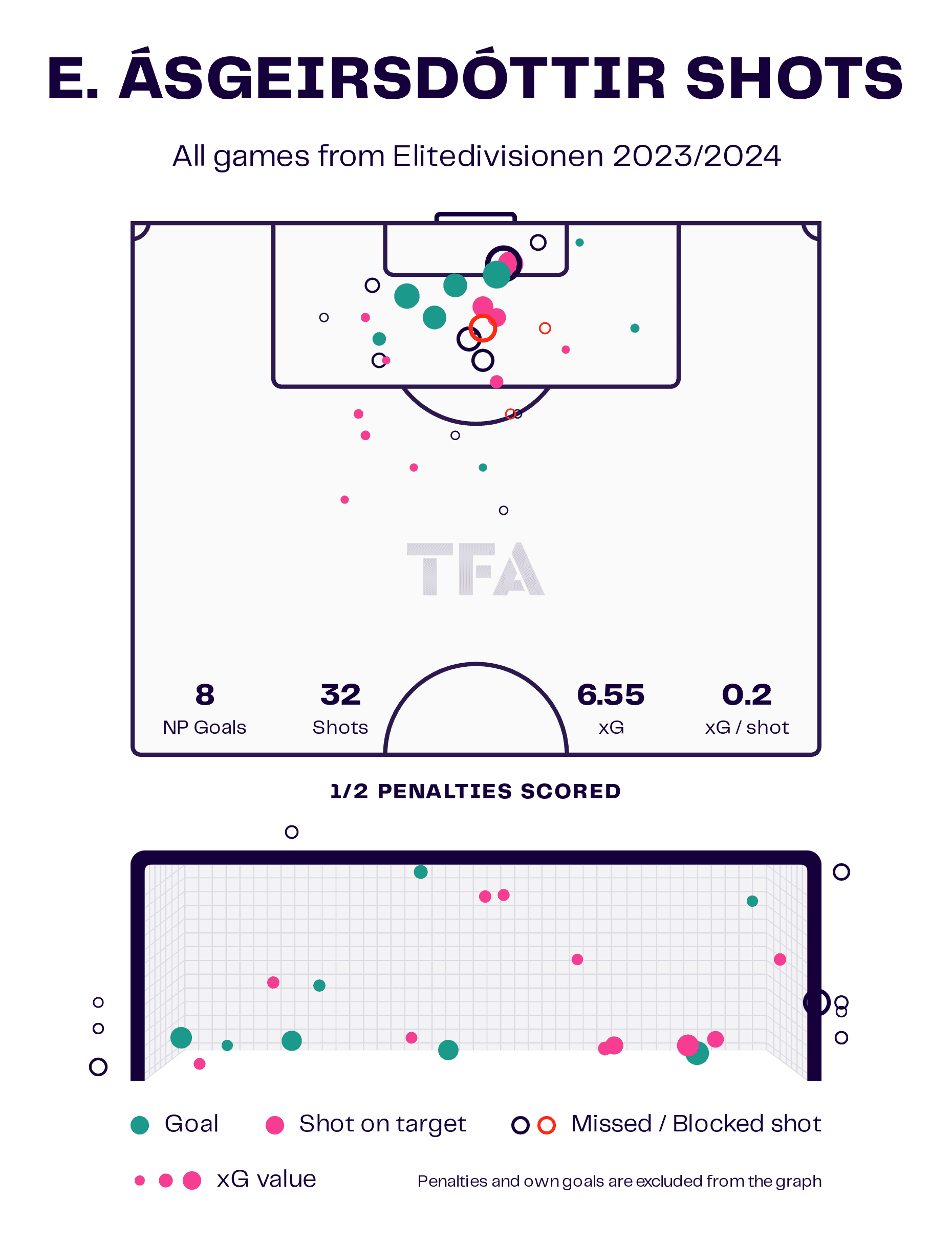
This creates a much clearer image of the data, showing the locations from which Ásgeirsdóttir is taking shots. You notice the high number of chances in and around the penalty spot, which are regarded as high xG chances. This suggests that she is consistently getting into good goalscoring positions. The other thing to note is that she still exceeds her xG by 1.45.
As you can see, Ásgeirsdóttir is a promising young goalscorer who is already integral to the Nordsjaelland attack.
Tilda Ratts (Finland) – Aland United – Striker
The next player we identified was the seventeen-year-old striker Tilda Ratts, who plays for Finnish side Åland, who competes in the Kansallinen Liiga, Finland’s premier division; they finished as the third-placed side in 2023. Although she may not immediately jump out from the data, we identified her several times as a consistently high performer in many vital areas.
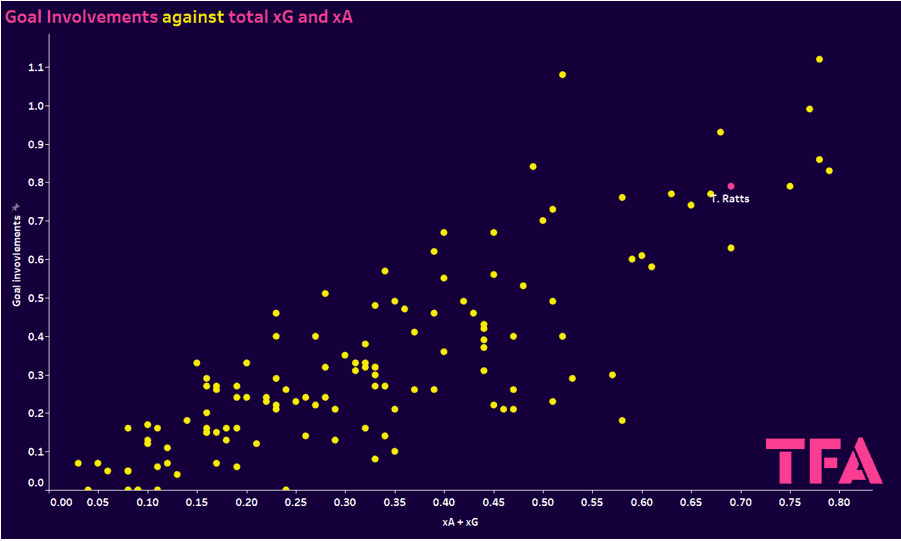
One of the areas in which Ratts performs well is goal involvements and combined xA and xG, with her being in the top ten performers of our data set in both categories. With 0.79 goal involvements per 90, she sits in ninth place. Then, regarding xG and xA, she had a combined average of 0.69 per 90, putting her in sixth place in this category. This shows the ability that Ratts has to be an essential member of the Åland side in terms of goalscoring.
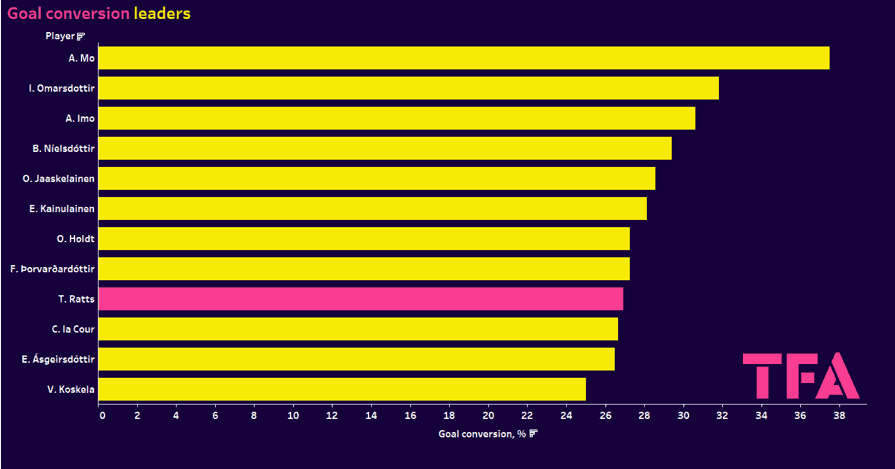
Then, to provide more context to this data, we will look at how efficient Ratts has been with her chances. In this category, she again remains in the top ten performers, sitting in ninth position with a conversion rate of 26.9%. This goes to show that not only is she a high performer in terms of output, but she is efficient with it as well.
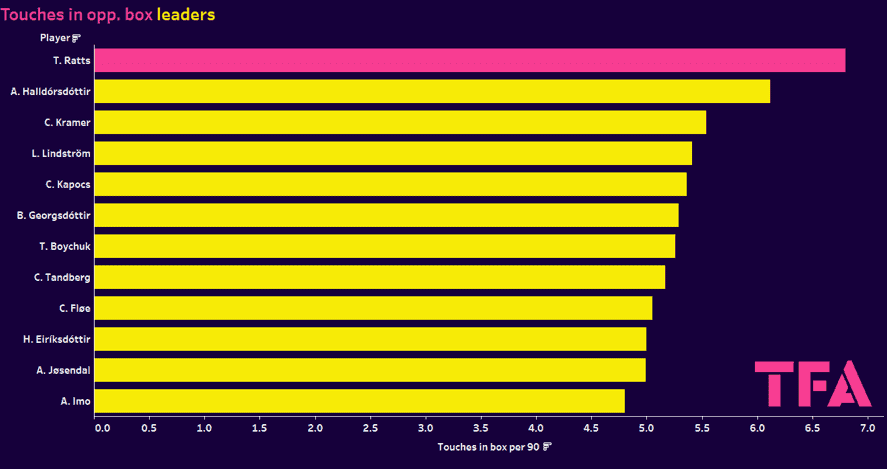
Through further examination of the data, we may have found a reason why she can convert consistently at such a high level. The data above shows the number of touches in the opposition box. You will notice how she leads the entire data set for this category by a significant margin with 6.8 touches in the box per 90, which is 0.68 better than the next best player, Halldórsdóttir, who we have looked at in some detail.
This suggests that she is occupying positions in the box which may equate to high-quality chances. We need to look at a shot map from Ratts 2023 campaign to see whether this is the case.
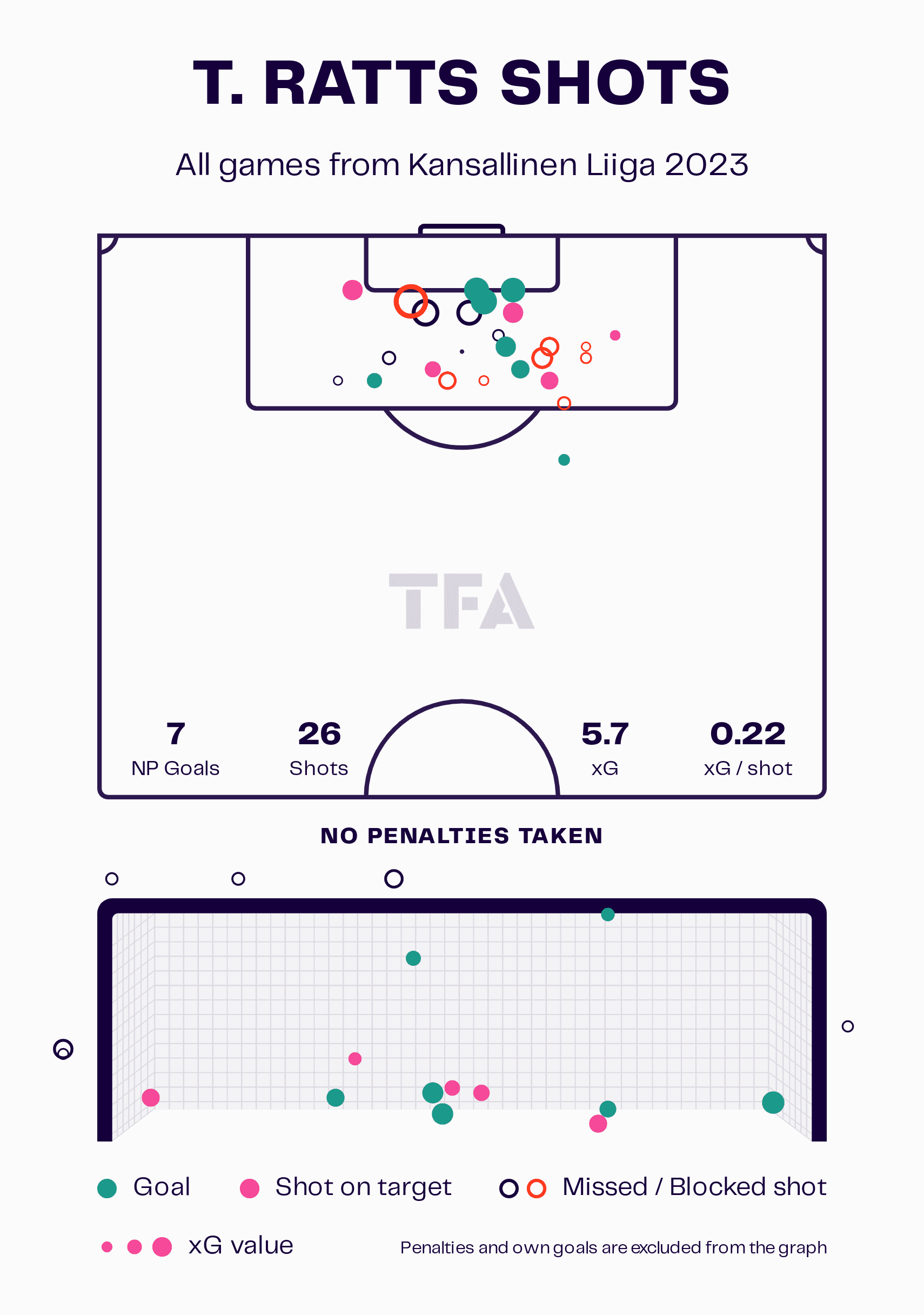
You will notice from the shot map that all but one of Ratt’s seven goals were scored from inside the box, with a significant proportion of her goals scored being high-quality chances located in and around the six-yard box. It is interesting to note that although she is scoring several of these changes in shot placement, a lot is placed towards the centre of the goal. However, more context about the delivery leading up to the shots would be needed to prove that she was inaccurate at shooting as she may just have had so-called ‘tap-ins’ where she didn’t need to put the ball into the corner of the goals.
As you can see, Ratts is an exciting young striker who, despite her tender age, is already performing as a high-quality striker for her side indeed; if she keeps getting into these positions consistently, she can continue to perform at a high level and potentially push on to a higher level in the future.
Conclusion
As you can see, there are a high number of quality players in the Nordic region with lots of potential as you can see already from the opening couple days of the transfer window, with Agnes Nyberg moving from Uppsala to expansion NWSL side Utah Royals, Matilda Vinberg from Hammarby to Tottenham and Norrkoping’s Lovisa Gustafsson to Spanish side to Huelva.
In this article, we picked out four players that stood out as interesting players to look at; however, many more could have been looked at, and I’m sure other names stood out to you as leading some interesting statistical areas.
Hopefully, our analysis has provided more context on some interesting attacking players, as this market is among the most interesting in Women’s football today.






Comments